Hydrogen is a very versatile energy carrier and is seen as a beacon of hope, especially with regard to the decarbonisation of industry.
As part of the manufacturing industry, Donauchem is dealing with the topic and is shedding light on the conditions that need to be created in order to promote the production of green hydrogen using renewable energies.
Worldwide, more than 600 billion cubic metres of hydrogen are consumed per year, 99 percent of it in industry. With the EU Hydrogen Strategy, climate-neutral hydrogen is to take a prominent place in European energy and climate policy in the future. Here is a brief overview of where the potentials and challenges of a hydrogen economy lie.
"I am convinced, my friends, that water will one day be used as a fuel. Water is the coal of the future."
Jules Verne, 1874
The EU Hydrogen Strategy for a Climate Neutral Europe
With the Green Deal, Europe has set itself the goal of reducing greenhouse gas emissions by 55% by 2030 compared to 1990 levels. By 2050, the EU's energy consumption is to be covered to a large extent by electricity generation from renewable energy sources. In 2020, however, only around 22 % of gross final energy consumption in the EU-27 was covered by renewable energies.
To close this gap, the
EU Hydrogen Strategy aims to make climate-neutral hydrogen competitive through incentives. Hydrogen technology could save about 560 million tonnes of CO
2 per year by 2050 (source:
EU Parliament report).
Green hydrogen should preferably be used in those areas where it can replace fossil fuels - be it in the production of hydrogen itself or for the
decarbonisation of processes that cannot be electrified. Transitionally, blue and turquoise hydrogen will also be used. The focus of the strategy is primarily on the areas of industry and mobility; the heat sector plays a subordinate role.
What makes hydrogen so interesting?
Hydrogen (H
2) is the most common element in our universe and, as a chemical element, is present in bound form in almost all organic compounds. It is fourteen times lighter than air, non-toxic, environmentally neutral, very volatile, does not ignite by itself and burns with a colourless flame without leaving any residue.
Above all, the following properties make the use of hydrogen interesting:
- Hydrogen stores energy and releases it again without emitting CO2.
- The chemical energy stored in hydrogen can be converted back into electrical energy using fuel cells.
- Hydrogen can be stored or transported over long distances by pipelines and ships.
- Hydrogen can serve as an efficient long-term storage for renewable energy.
- When hydrogen is burned, no polluting exhaust gas is produced, only water.
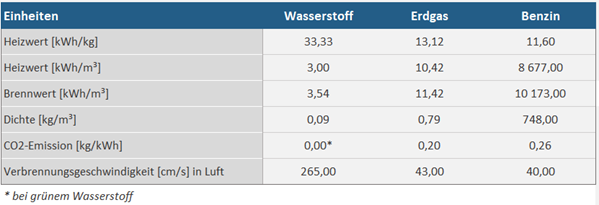
How is hydrogen produced?
To make hydrogen usable as an energy carrier, it has to be split off by various processes. Depending on how much CO
2 is produced in the manufacturing process or how it is further processed, we speak of grey, blue, turquoise or green hydrogen.
1. Green hydrogen: electrolysis process
The electrolytic production of hydrogen is the simplest process in terms of technology and a very efficient process in terms of the electrical energy used. If the required electricity is obtained from renewable sources, it is called green hydrogen. Other possibilities for producing CO
2-neutral hydrogen are the gasification and fermentation of biomass and the reformation of biogas.
2. Grey and blue hydrogen: reforming processes
On an industrial scale, hydrogen is mainly produced on the basis of fossil energy carriers, primarily from natural gas by adding steam (steam reforming). This process produces CO
2 as a by-product in addition to "grey" hydrogen. If the CO
2 is captured directly in the production process and stored underground (Carbon Capture and Storage, CCS) or further processed as a raw material (Carbon Capture and Utilisation, CCU), we speak of blue hydrogen. As long as the captured CO
2 is not released into the atmosphere, this is also considered climate-neutral.
3. Turquoise hydrogen: methane pyrolysis
In methane pyrolysis, natural gas, for example methane (CH4), is split by adding heat. This produces hydrogen and solid carbon. If only renewable energies are used to supply the high-temperature reactor with energy, we speak of turquoise hydrogen. To be considered CO
2-neutral, the carbon produced must be bound in the long term, for example in the construction and materials industry or in road building.
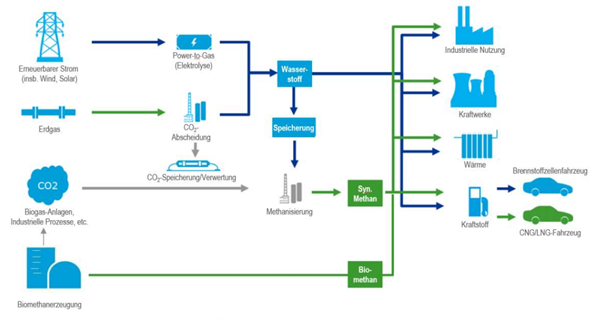
Renewable energy is used for water electrolysis to split water (H
2O) into hydrogen (H
2) and oxygen (O2) using electricity. The hydrogen produced in this process can be used directly or stored. ©
The role of gas in the future energy carrier mix, E-Control
Power-to-gas: Hydrogen as flexible storage for renewable energies
The fundamental advantage of hydrogen is to compensate for the disadvantages of renewable energy compared to fossil energy sources. This is because the latter have properties that do not yet make it possible to completely dispense with fossil fuels. These include the following aspects in particular:
- Weather dependency of generation
- Environmental protection problems (e.g. hydropower plants)
- Effectiveness and amortisation
- Lack of base load and peak load coverage
- Lack of energy storage options

In this context, hydrogen offers the possibility of supplying renewable energy via the natural gas grid to consumers and gas storage facilities with the help of power-to-gas technology (PtG). In an additional process step, other energy carriers can be produced.
The process consists of three phases:
- Generation: Renewable electricity is produced with wind and solar plants.
- Electrolysis: In the plant, surplus electricity is converted into gas through electrolysis and stored in the existing natural gas infrastructure. The gas can then be transported and reused as needed, e.g. for industrial processes, heat or propulsion energy.
- Synthesis: In a further step, it is also possible to convert the hydrogen into methane, methanol, fuel (petrol, diesel, paraffin) or ammonia. This makes it possible to use green energy in maritime and aviation applications and to become independent of oil or natural gas.
In order to make hydrogen available as an energy carrier in the short term, underground storage facilities or new technologies that store hydrogen in oil (LOHC technology) are possible in addition to the gas grid.
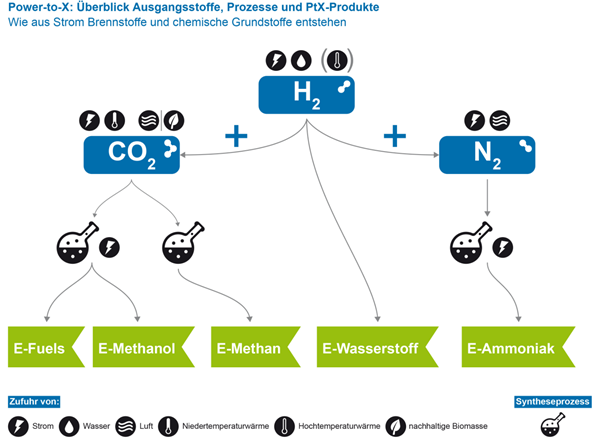
Öko-Institut,
Power-to-X. Overview of feedstocks, processes and PtX products,
CC BY-SA 2.0
Power-to-gas opens up options for integrated energy systems
Power-to-gas not only enables the replacement of fossil energy sources, but also ensures a stable energy supply by equalising the fluctuating renewables. In the medium term, the process could contribute significantly to solving the problem of intermediate storage of renewable electricity economically. This opens up many options for integrated energy systems and the coupling of the electricity, heat and mobility sectors.
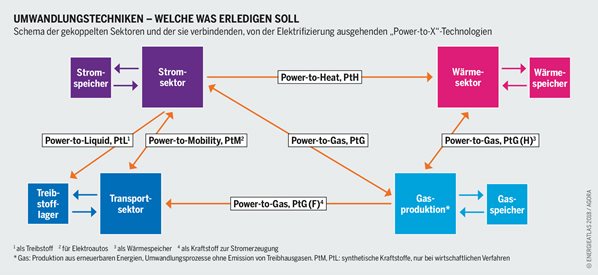 »Umwandlungstechniken - Welche was erledigen soll« Abbildung: Bartz/Stockmar
»Umwandlungstechniken - Welche was erledigen soll« Abbildung: Bartz/Stockmar,
CC-BY 4.0
Hydrogen in industry
For material applications in the chemical industry, grey hydrogen is used almost exclusively, for example in the production of nitrogen fertiliser, the refining of mineral oil or in the production of synthetic fuels. The problem is that the production process generates about 10 tonnes of CO
2 per tonne of hydrogen produced. By using green hydrogen, a lot of CO
2 can be saved in this area.
Hydrogen also has great potential where it can replace fossil fuels. This is especially true for industrial processes that cannot be electrified, or only at disproportionately high cost, for example steel production or ammonia production. At present, natural gas or coal are mostly used for this, but in the future these processes could increasingly be converted to hydrogen.
Another field of application is hydrogen, which is a by-product of chemical processes and can be utilised as part of a
company's internal recycling management. The new hydrochloric acid synthesis plant of Donau Chemie AG in Brückl, for example, uses a technology that converts waste gases from contaminated hydrogen into high-purity hydrogen. This hydrogen is then used as fuel for steam generation and thus thermally utilised. The annual saving of fuel oil amounts to 1,300 tonnes, and at the same time CO
2 emissions are reduced by 4,600 tonnes per year.
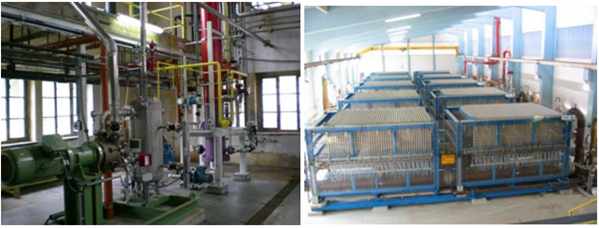
Impure hydrogen is fed into the heat cycle after conversion into high-purity hydrogen. © Donau Chemie AG
Hydrogen in heat supply
The use of renewable and decarbonised gases makes it possible to reduce greenhouse gas emissions in all sectors of the heating market - from blast furnaces to boilers. In pilot projects, the admixture of up to 30 % hydrogen in natural gas networks is already being researched. In the case of stationary fuel cells, natural gas is an energy carrier that can be used in almost every home.
Hydrogen in the mobility sector
In the mobility sector, green hydrogen offers an alternative in areas where electrification is not possible or sensible. For example, in heavy-duty transport the electricity consumption would be enormously high to achieve the required ranges. Power generation in hydrogen fuel cells, on the other hand, can circumvent these problems. In addition, fuel generated from hydrogen can be used in vehicles, ships and aircraft in a climate-friendly way. There are also initial projects for the use of hydrogen in trains.

K. Müller,
Schematic of energy storage via chemical H2 storage,
CC BY-SA 3.0 EN
What challenges await on the road to a hydrogen economy?
The main problem at present is the availability of renewable energies and the still relatively high production costs of hydrogen.
1. Expanding renewable energies
The fundamental prerequisite for the successful implementation of the hydrogen strategy is the consistent expansion of renewable energies. In order to achieve this goal, work is currently underway on the revision of the Renewable Energies Directive (
RED II) as part of the "
Fit for 55" package. The aim of the directive revision is to promote investments in existing or new renewable energy technologies. At the same time, it is planned to increase the overall renewable energy target from 32 % to 40 % by 2030.
2. Production costs for green hydrogen
The production costs of hydrogen by electrolysis are currently still high. However, it is expected that by 2030, economies of scale and falling energy prices will reduce costs by 30 %. In areas with cheap renewable electricity, green hydrogen could then already be competitive by 2030.
3. Development of a hydrogen infrastructure
Various options are available for the transport of hydrogen. In addition to pipeline-based transport, trucks or ships can also be considered. Hydrogen can also be transported as ammonia. The EU's preference is for a gradual conversion of natural gas networks to hydrogen networks. The EU Commission, on the other hand, is critical of the admixture of hydrogen into the gas stream, as this could lead to an undesirable fragmentation of the domestic market.
4. Efficiency of fuel cells
Energy is lost when hydrogen is converted into electrical energy. Currently, the efficiency is about 50 to 60 percent. Scientists are already working on improving the efficiency, durability and performance of fuel cells. In the future, it is expected that the efficiency will increase significantly. Currently, research is being conducted on the use of hydrogen in connection with fuel cell systems in portable power supply for electrical appliances and camping, as well as the application in small power plants.
5. Hydrogen filling stations
The widespread mobile use of fuel cells in transport is tied to the development of a hydrogen filling station network. Otherwise, it will be difficult for the technology to gain acceptance among car manufacturers. Conversely, it is to be feared that there will be no filling station network as long as there are no fuel cell cars that are ready for series production and affordable.
Conclusion: Hydrogen as a key technology for the energy transition
Achieving the climate targets requires the interplay of all available technologies. Hydrogen plays a key role in this respect. It can replace fossil fuels, serve as a storage medium for renewable energies, enable mobility and link the various energy sectors. In order to meet the growing demand for climate-neutral hydrogen, start-up financing and the expansion of renewable energies are essential. In addition, incentives are needed for a timely rollout as well as viable economic framework conditions.
 www.donauchem.at
Related links/sources:
www.donauchem.at
Related links/sources:
These are the new hydrogen projects in Europe (as of 20.4.22)
www.chemietechnik.de
FCIO: Energy and climate policy with a sense of proportion
www.fcio.at/themen/energie-klima/